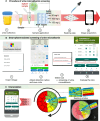Instant and low-cost detection of urinary microalbumin using smartphone technology and a paper-based platform with a colorimetric ratio analysis
- PMID: 40216880
- PMCID: PMC11992030
- DOI: 10.1038/s41598-025-96916-5
Instant and low-cost detection of urinary microalbumin using smartphone technology and a paper-based platform with a colorimetric ratio analysis
Abstract
Early detection of microalbuminuria is essential for preventing the progression of nephropathy and improving patient management. The present research proposes a simple, low-cost dye-binding method based on a standard addition principle for determining urinary albumin at clinically significant levels. The assay principle of the proposed paper-based analytical device is based on utilizing a specific and sensitive dye, bis(3',3″-diiodo-4',4″-dihydroxy-5',5″-dinitrophenyl) -3,4,5,6-tetrabromosulfonphthalein (DIDNTB), which binds to urinary albumin under extreme low pH conditions. The strategy was based on testing with three different albumin concentrations in the urine samples to obtain different color intensity ratios denoted as R1, R2, and R3, and further used to calculate a semi-quantitative amount of albumin. Under the optimized conditions, the linear range from 10 to 200 mg/L albumin and the detection limit 8.2 mg/L (R2 = 0.99) was obtained. Interference studies revealed that glucose, ascorbic acid, uric acid, L-histidine, and globulin were in the acceptable recovery range (89-109%). Reproducibility assessments showed that the coefficients of variation (CV) for this method ranged between 3.7% and 7.7%. Additionally, receiver operating characteristic (ROC) plots were generated to establish the cut-off value for instant semi-quantitative interpretation of the results. Results from real sample analysis revealed that the proposed method is comparable to a widely used quantitative immunoturbidity method (r = 0.94, n = 50).
Keywords: Colorimetry; Microalbuminuria; Paper-based analytical device; RGB detector; Smartphone.
© 2025. The Author(s).
Conflict of interest statement
Declarations. Competing interests: The authors declare no competing interests. Ethical considerations: The study was approved by the Ethics Review Committee for Research Involving Human Research Subjects, Health Sciences Group, Chulalongkorn University (ECCU), Bangkok, Thailand (COA No. 166/65). This approval was granted under the principle of the Office for Human Research Protections (OHRP, Exempt Categories) 45 CFR Part 46.101(b), as the research activities met the criteria for exemption. The study utilized de-identified samples leftover after the completion of diagnostic tests. Hence, as per the regulations of the institutional ethics committee, no informed consent form was required. We confirm that all methods were carried out in accordance with relevant guidelines and regulations.
Figures






Similar articles
-
Verification of the Reliability of an Automated Urine Test Strip Colorimetric Program Using Colorimetric Analysis: Survey Study.JMIR Form Res. 2025 Jan 14;9:e62772. doi: 10.2196/62772. JMIR Form Res. 2025. PMID: 39810396 Free PMC article.
-
Sensitive colorimetric assay for uric acid and glucose detection based on multilayer-modified paper with smartphone as signal readout.Anal Bioanal Chem. 2018 Apr;410(10):2647-2655. doi: 10.1007/s00216-018-0939-4. Epub 2018 Feb 17. Anal Bioanal Chem. 2018. PMID: 29455281
-
Colorimetric detection of glucose in food using gold nanoparticles as nanoenzymes combined with a portable smartphone-assisted microfluidic paper-based analysis device.Spectrochim Acta A Mol Biomol Spectrosc. 2025 Mar 15;329:125523. doi: 10.1016/j.saa.2024.125523. Epub 2024 Dec 3. Spectrochim Acta A Mol Biomol Spectrosc. 2025. PMID: 39674109
-
A novel smartphone-based CD-spectrometer for high sensitive and cost-effective colorimetric detection of ascorbic acid.Anal Chim Acta. 2020 Jan 6;1093:150-159. doi: 10.1016/j.aca.2019.09.071. Epub 2019 Oct 2. Anal Chim Acta. 2020. PMID: 31735208
-
Smartphone-assisted colorimetric detection of uric acid based on the enhanced peroxidase-like activity of Cu doping Prussian blue.Spectrochim Acta A Mol Biomol Spectrosc. 2025 May 15;333:125898. doi: 10.1016/j.saa.2025.125898. Epub 2025 Feb 11. Spectrochim Acta A Mol Biomol Spectrosc. 2025. PMID: 39965283
References
-
- Levey, A. S. et al. Definition and classification of chronic kidney disease: a position statement from kidney disease: improving global outcomes (KDIGO). Kidney Int.67, 2089–2100. 10.1111/j.1523-1755.2005.00365.x (2005). - PubMed
MeSH terms
LinkOut - more resources
Full Text Sources
Miscellaneous

